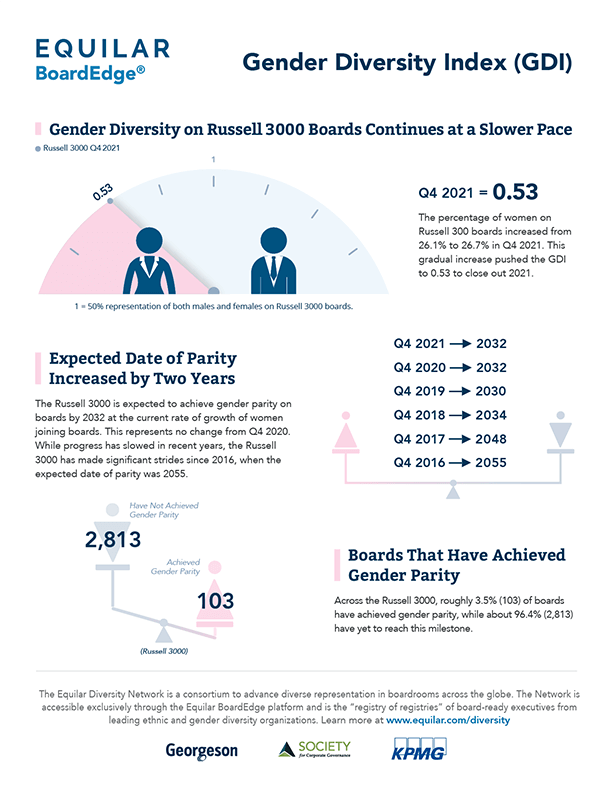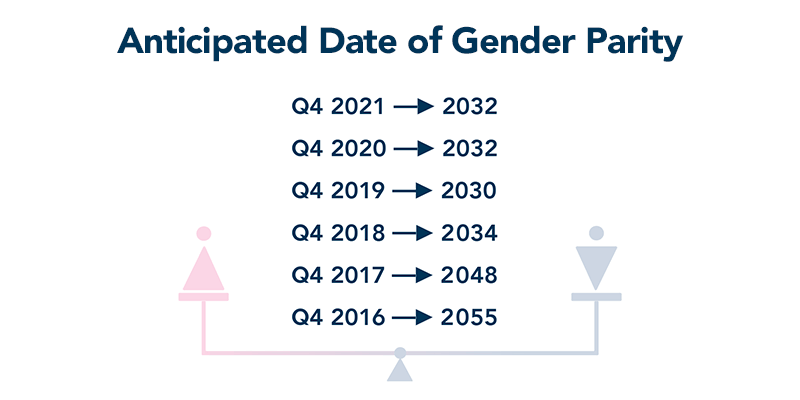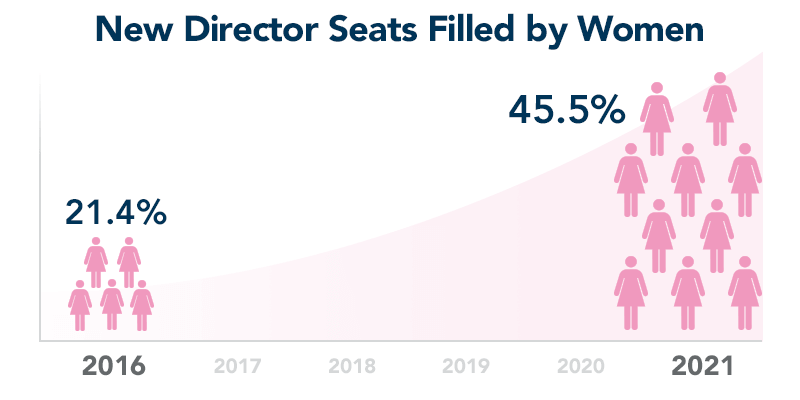Q4 2021 Equilar Gender Diversity Index
Russell 3000 Boards Make Incremental Progress, on Pace to Achieve Gender Parity by 2032
March 8, 2022
Amit Batish
As the focus on diversity across Corporate America continues to sharpen, the number of women serving as board members at the largest U.S. companies has risen steadily. Featured in the Associated Press’ coverage of International Women’s Day 2022, the most recent edition of the Equilar Gender Diversity Index (GDI) revealed that 26.7% of Russell 3000 board seats were held by women as of the end of Q4 2021, a modest increase from the 26.1% as of Q3 2021. As a result, the needle on the Equilar GDI inched forward from 0.52 to 0.53, with 1.0 representing complete gender parity.

One year earlier, women held 23.5% of board seats, and five years earlier that figure was just 15.1%. Several factors, led by various stakeholders, have contributed to the push for diversity on boards in recent years. With the passage of bills like SB-826 and AB-979, California provided a template for states and other institutions looking to encourage corporate diversity. While similar laws have yet to come to fruition in many other states and are unlikely to pass at the federal level any time soon, the SEC’s approval of Nasdaq’s board diversity listing rules last year signaled a potential future for more widespread diversity requirements.
The rule requires most Nasdaq-listed boards, other than exempt entities and companies with boards consisting of five or fewer members, to have at least one woman in addition to at least one member of any gender from underrepresented groups defined by race, ethnicity, or sexual orientation. In lieu of compliance, Nasdaq-listed companies can explain why they cannot or will not meet these requirements in public disclosure. The Nasdaq requirements, along with increased scrutiny from institutional investors and new guidelines from proxy advisory firms, will require companies to be transparent when discussing the composition of their boards.
According to Brigid Rosati, Managing Director, Business Development and Corporate Strategy, at Georgeson, such transparency requires proper disclosure of diversity information. “Many investors have turned their attention to diversity disclosure as a way to assess board composition and measure progress on board diversity,” said Rosati. “Companies should expect to see investor demand for enhanced board diversity reporting and workforce diversity data.” While the abundance and nature of diversity laws and regulations may change in the coming years, further progress will require a transparent, thoughtful and comprehensive approach.
When Will the GDI = 1.0?
Along with the snapshot statistics of female directorships each quarter, Equilar’s GDI projects the year during which the Russell 3000 will finally reach gender parity. Due to the ubiquity of this topic in the public sphere, along with the myriad challenges associated with the pandemic, this projection has fluctuated in the past several years.
As of 2017, the Russell 3000 was projected to reach gender parity by 2048. From 2017 to 2019, the rate of female appointments rose considerably, which in turn dragged the parity projection down to 2034 as of 2018. 2019’s projection was the most optimistic, with parity expected by 2030. Since then, that figure rose slightly back up to 2032 in 2020 and remained there in 2021. This may in part be due to the unforeseen circumstances surrounding the pandemic, as well as a growing focus on improving with respect to other forms of diversity outside of just gender.

Milestones Surpassed in Q4 2021
The increase in overall female representation was not the only positive trend observed over the past quarter. Perhaps the most significant development during Q4 was an increase to the number of Russell 3000 companies to reach gender parity. At 103 companies, this is the first quarter in the recorded history of the GDI in which more than 100 companies have achieved equal representation of male and female directors. While this is still a meager figure in the grand scheme of the Russell 3000, it is a vast improvement from the 21 companies to have achieved this feat in Q4 2016.
In addition, Q4 2021 also became the first quarter in which the number of boards to reach parity eclipsed the number of boards with zero women directors. Completely male-dominated boards fell from 96 in Q3 to just 80 in Q4. Ideally, it will only be a matter of time before this figure hits zero; however, the fact that so many companies have yet to appoint a single female director is a symbol of the work that remains. “These companies should prepare to explain the lack of female directors to their shareholders this coming AGM season,” said Rosati. “Many of these companies will be deemed laggards and likely receive shareholder opposition to directors on the nominating committee.”
While the Russell 3000 as a whole remains just over half way to gender parity, the makeup of newly appointed directors paints a more hopeful picture. During Q4 2021, 47.7% of open board seats were filled by women, tying a record number set in Q3 of last year. This figure may not be sustainable in the path toward overall gender parity, but it is an improvement from the 44.2% of new seats filled by women in Q4 2020 and the 21.4% in 2016.

Progress is also not limited to just the boardroom. According to an Equilar study featured in CNBC’s TechCheck, the growth rate of women in Russell 3000 executive leadership roles accelerated to an average pace of 6.9% from 2016 to 2021, up from 3.8% in the prior five years. Due to this increased pace, women held 14% of named executive officer (NEO) roles in 2021. While this figure is still quite low, it represents steady progress from a decade ago when women held just 8% of these positions in 2010. It’s become evident that companies are making a concerted effort to drive diversity across all levels of corporate leadership.
Lingering Roadblocks to Equal Representation
A significant roadblock in the march toward equal representation is the disparity between men and women directors who serve on multiple boards. In Q4, 25.6% of women in the Russell 3000 served on more than one board, in comparison to the 17.1% of men who were multi-boarded. While the women who earn multiple directorships undoubtedly do so by the merit of their professional credentials, this consistently high figure highlights potential issues for the framework of many diversity initiatives.
“The pipeline of female candidates is strong and increasingly inclusive as women of color and openly LGBTQ+ women continue to gain visibility as board candidates,” explained Susan Angele, Senior Advisor of Board Governance at KPMG’s Board Leadership Center. “Boards are less frequently insisting on recruiting only from the ranks of CEOs and CFOs and instead are building boards with diverse sets of experiences to bring new lenses to the boardroom discussion, such as technology, culture, ESG, talent, crisis leadership, and public policy expertise, among others.”
There is no shortage of highly qualified female candidates for board positions, but many companies are consistently choosing to pull from a very small pool of candidates. Despite a lack of progress up to this point, Angele points to a potentially positive trend on this issue. “The number of organizations committed to helping raise the visibility of talented first-time board candidates in order to connect relevant openings is continuing to grow and this movement is slowly but surely making an impact,” said Angele.
Unsurprisingly, there is still significant progress that must be made. The supply for diverse directors has long outweighed the demand from top companies, a fact that will likely remain true for years to come. Thankfully, progress continues to be made across the board, albeit at varying speeds. Stakeholders remain optimistic as to whether or not recent regulatory and legislative efforts will achieve their goals in the long run, but Equilar’s GDI reflects mostly positive returns in the short run.
About Equilar Gender Diversity Index
The Equilar GDI reflects changes on Russell 3000 boards on a quarterly basis as cited in 8-K filings to the SEC. Most indices that track information about board diversity do so annually or even less frequently, and typically with a smaller sample size, sometimes looking back more than a full year by the time the information is published. While this data is reliable and accurate, the Equilar GDI aims to capture the influence of the increasing calls for diversity from investors and other stakeholders in real time.
The Equilar GDI is powered by Equilar BoardEdge, a database of more than one million public company board members and executives. BoardEdge includes exclusive features that show how board members and companies are connected to each other, as well as the Equilar Diversity Network (EDN), a “registry of registries” of board-ready executives from leading ethnic and gender diversity partnerships, organizations, and publications.
Contact

Amit Batish
Director of Content at Equilar
Amit Batish, Director of Content at Equilar, authored this post. Brendan Cullen, Forrest Rouleau, Leo Rubenstein and Kelly Stangl contributed data and analysis. Please contact Amit Batish, Director of Content and Communications, at abatish@equilar.com for more information about this article.
 Solutions
Solutions














